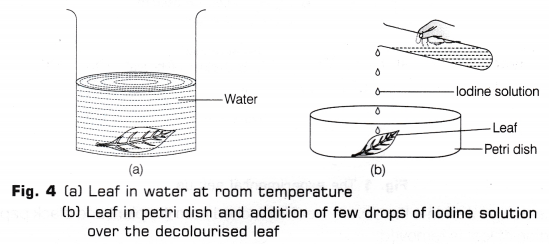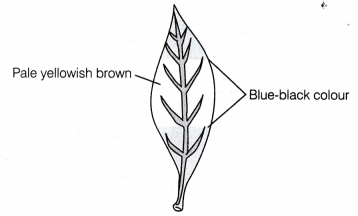CBSE Class 10 Science Lab Manual – Light is Necessary for Photosynthesis
Aim
To show necessity of light during the process of photosynthesis.
Materials Required
Well watered de-starched potted plant (balsam, Amaranthus, Tecoma or any plant with thin herbaceous broad leaves), thick black paper strips or Ganong’s light screen, paper clips, forceps, alcohol, iodine solution, beaker (250 ml), burner (or spirit lamp ), a tripod stand, wire gauge, boiling tubes, a petridish and water.
Theory/Principle
Plants are autotrophic organisms, i.e. they make their own food. Photosynthesis is the process, by which green plants synthesises their food using CO2 , water, sunlight and an essential photosynthetic pigment called chlorophyll, which is present in chioroplast of leaf, hence the leaf is also called as photosynthetic organ of the plant.
The overall photosynthetic reaction can be expressed as:

Light is one of the major components for occurrence of photosynthesis reaction.
It provides energy for further reaction. The light energy from the sun is absorbed by the chlorophyll pigment and is converted into chemical energy which is utilised by the plants.
Process of photosynthesis involves:
- Absorption of light energy by chlorophyll pigment. This process involves splitting of water molecules to hydrogen and oxygen.
- Conversion of this energy to chemical energy via breakdown of CO2 to form glucose.
The process of photosynthesis is greatly affected by the absence or presence of sufficient supply of light.
Importance of light in photosynthetic reaction is studied by conducting this experiment.
Procedure
- Take a de-starch (without or minimal starch) plant [Amaranthus, Tecoma, etc.) with broad leaves. If a de-starch plant is not available, then take any healthy potted plant and keep it in complete darkness for 2-3 days to de-starch it.
- Choose any healthy leaf from this plant. Cut two uniform pieces from the black paper and cover a portion of the leaf from both sides, holding the paper with paper clips.
Note Ganong’s light screen can also be used in place of black paper strip. - Place this set up (Fig. 1) in bright sunlight for about 8-10 hours.

- After the designated time the covered leaf is plucked from the plant and black paper covering the portion of leaf is removed.
- Take about 150 ml of water in a beaker and boil it.
- Add the experimental leaf into it till the leaf becomes soft (Fig. 2). Switch off the burner and allow the water to come down to a temperature of 60°C.

- Transfer the leaf to a boiling tube containing alcohol.
- Place this set up again in hot water beaker, with temperature maintained at 60°C. Keep the tube in this set up till the leaf become colourless (decolourisation of leaf) as shown in Fig. 3.

- Take the leaf out and wash it with water [Fig. 4(a)]. In a petri dish, place this leaf and add a few drops of iodine solution to it [Fig. 4(b)], Leave the set up for 5 minutes.

- Remove the leaf from iodine solution and wash it with water and observe the colours of exposed and unexposed parts of the leaf.
Observation
After treating the leaf with iodine solution (see Fig. 5) following observations were made

- The exposed or uncovered part of the experimental leaf turns blue black in colour.
- The portion of the leaf that was covered with black strips has no appearance of blue colour, it turns to a pale yellowish brown.
Result
Plants produce food, i.e. carbohydrates in the form of starch as one of its end products. From the above observations, we conclude that
- Starch is present in the uncovered part of leaf because it is getting all the sufficient sources for its synthesis, i.e. water and light. Hence, the uncovered parts gives positive result when tested with iodine solution.
- Starch is absent in the covered part of leaf because the process of photosynthesis did not occur in this part due to absence of light. Hence, when tested with iodine, it gives a negative test. Thus, light is very important for occurrence of photosynthesis.
Precautions
- The experimental leaf should be healthy.
- The plant used in this experiment should be completely de-starched for satisfactory result.
- While clipping the leaf, be gentle, do not tear the leaf.
- Direct heating of alcohol is avoided as it is inflammable and will catch fire. Use a water bath for this purpose.
- Wash the leaf before iodine testing.
Viva – Voce
Question 1.
What is meant by de-starching? Why do plants get de-starched when kept in continuous darkness for about forty eight hours? [NCERT]
Answer:
De-starching refers to the complete removal of starch from a plant. Plants kept in darkness for long duration are not able to carry out photosynthesis process due to the absence of light. The plant then uses its stored starch supply leading to de-starching.
Question 2.
Will you get the same result, if you perform the experiment without de-starching the plant. Give reason. [NCERT]
Answer:
No, the results will not be the same because the starch stored in plants will interfere with the result.
Question 3.
Why do we warm the leaves in alcohol? [NCERT]
Answer:
Alcohol is used because it removes the chlorophyll pigment and decolourise the leaves which help in clear detection of changes during iodine test.
Question 4.
Arrange the following steps in correct sequence
- De-starching the plant
- Treatment with iodine
- Attaching black paper strips to the leaf
- Keeping the set up in sunlight [NCERT]
Answer:
1, 3, 4 and 2
Question 5.
Why do we keep the experimental plant in bright sunlight? [NCERT]
Answer:
The plant will perform photosynthesis when kept in bright sunlight.
Question 6.
Can this experiment be performed with a de-starched leaf detached from the plant? Give reasons. [NCERT]
Answer:
No, because another raw material, i.e. water is supplied byxylem from roots to the leaves for photosynthesis. Thus, leaf detached from plant cannot perform photosynthesis.
Question 7.
Photosynthesis occurs in which ceils of plants?
Answer:
Mesophyll cells.
Question 8.
During the process of photosynthesis, glucose is released as the end product, then why is the iodine test performed?
Answer:
In plants, carbohydrates are used and stored in the form of starch by polymerisation of glucose molecules. The presence of starch can be easily detected by change in colour of leaf by iodine solution. Hence, iodine test is performed over glucose test.
Question 9.
Black paper strips are used to cover a portion of leaves in this experiment. Why?
Answer:
Black colour is a good absorber of light, thus it blocks the light rays to reach the covered part and stop photosynthesis process.
Question 10.
During photosynthesis, the light energy is trapped by which cell organelle?
Answer:
Chloroplast (i.e. a type ofplastid) traps the light energy.
Question 11.
What are the features present in green leaves that make it suitable site for photosynthesis?
Answer:
These features include:
- Large leaf surface area for absorbing maximum light.
- Numerous stomata.
- Presence of chloroplasts in mesophyll cells.
Question 12.
Which fraction of light is used during the photosynthesis by plants?
Answer:
Visible light.
Question 13.
Why does the portion of leaf covered with black paper strips not respond to iodine test?
Answer:
It is so because iodine test is positive only with starch. This portion did not have starch due to non-availability of light for photosynthesis so, it does not respond or show blue-black colour to the iodine test.
Science Lab ManualScience Practical SkillsScience LabsMath LabsMath Labs with Activity
